- Home
-
Properties
- Properties by type
- Properties by location
- Easy steps to buy property in BG
- Why Bulgaria
- News
- About Bulgaria
- Legal Advice
- F.A.Q
- About us
- Contacts
- Search
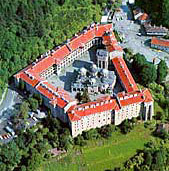
It was founded in the l0th century by the Bulgarian monk St. Ivan of Rila and was rebuilt in the l3th -l4th century. From that time are the fortress tower (1334), the bishop's throne, richly carved doors and some manuscripts, icon-paintings and church plates. In the l5th century, when Bulgaria fell to the Ottoman Turks, the monastery was abandoned for a short time but in the second half of the same century it was restored to a new life. The Rila Monastery has been listed as a world monument of culture. There is an interesting legend surrounding Rila monastery and its Saint, Ivan, who lived in the 10th century. After his parents' death, he gave away all of his material items, left his village and went to live in a cave in the Rila mountains. One can visit the cave today. Ivan lived without material possessions and grew healthier and stronger than he had ever been. For many years people visited him in his cave when they were sick in order to be healed. Upon Ivan's death, his body was wrapped in a shroud and buried. His body did not decay, however, and all those that visited his tomb were cured of their sicknesses.
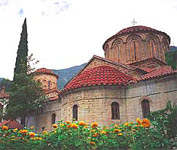
Bachkovo Monastery is located 28 km South-West of Plovdiv city. It was built in 1083 by Grigor Bakuriani, a military in the Byzantine Empire, a Georgian by origin. The ossuary with its exquisite architecture and wall-paintings dates from that time. The winter church of the Archangels dates in all likelihood to the l2th century. In the early l6th century the monastery was destroyed by the Turkish conquerors to be restored in the late l6th century. Of great interest are the monastery refectory (1601), the church of the Assumption (1604) with murals dating from 1643, and the domed church of St Nicholas (1837), decorated in 1840 by the Revival Period painter Zahari Zograph.
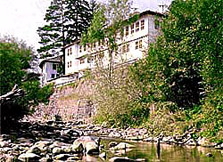
Trojan monastery must have been in existence long before the l5th century, as legends suggest. It flourished again about the year 1600. From the oldest church it is only the throne stone that has been preserved. Towards the beginning of the l9th century the monastic brotherhood re-erected the monastery. In 1835 master Konstantin built a wonderful main church which was painted by Zahari Zograph in 1847-1849. The spacious residential wings with roomy verandas were built in 1835-1855. In 1865 a tower was raised in the monastery courtyard with a winter church and a belfry on the last floor.
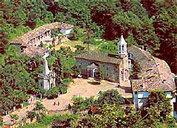
Dryanovo Monastery of St. Archangel Michael was founded in the l2th century and is in close proximity to the summer residence of the Bulgarian rulers from the Assen dynasty. It was destroyed several times during the Ottoman domination. In its present-day site the monastery exists since 1845. The main church was built in 1861. Almost ruined after the Ottoman Turks' invasion, the monastery buildings were restored in 1880. Next to the church there is the ossuary raised in memory of the perished insurgents. In the monastery you can also find a museum collection with exhibits from all historical epochs including neolithic finds from a nearby cave.
The Monastery of Batoshevo was founded in the 13th century under the reign of King Mikhail Asen. It is located in the hearth of Balkan Range mountain, near the village of Batoshevo. The monastery had been burned to ashes during the Ottoman slavery. Years of abandonment had followed. In 1831 its restoration had began and new wings with monastic cells had been built up. However, in 1876 the monastery has been burned down again having been a constant hiding place of one of the leaders of the Bulgarian organized revolutionary activity - Angel Kanchev. After the liberation the monastery has been fully restored.

This is one of the few preserved and accessible rock monasteries in Bulgaria, dating from the time of the Second Bulgarian Kingdom (12th -14th century) and it was most likely inhabited until the 18th century. Monastic cells and a small church have been dug into a sheer rock, 14 km from the city of Varna and close to the Black Sea resort of Golden Sands. Differently colored 13th-14th century frescoes are still discernible on its walls, but only few of them are preserved. The church has a wood-carved iconostasis.
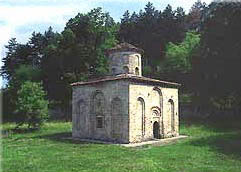
This monastery is to be found amidst the picturesque Zemen Gorge on the bank of Strouma River about two kilometers south-west of the town of Zemen. The oldest building in the monastery is its church, built of shapely cut tufa blocks. It is a cruciform structure almost resembling a giant cube with a central cupola that stands on four huge pillars of solid masonry; arcades connect them with the exterior walls. According to various sources this temple was built in the 11th century.
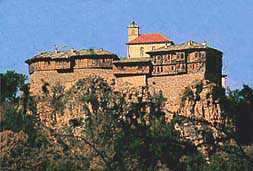
The Monastery of Glojen is situated above Glozhene village, 12 km north-east of the roadside complex "Pravets". It is founded in 1224 by the Russian knyaz Georgiy Glozh. The small church, dating back to 15th - 16th century, has been destroyed by the earthquake in 1913, and later a new one has been built up. Medieval and Renaissance icons, as well as religious books have been preserved to the present day. The monastery had been a hideout of the famous Bulgarian revolutionist Vasil Levski.
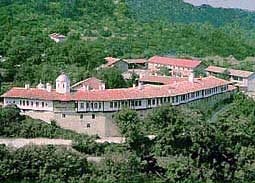
The Monastery of Kapinovo "Sveti Nikola" is to be found 6 km southwest of village of Kapinovo ( 20 km southeast of Veliko Turnovo). It is founded in 1272 by tsar Konstantin Asen Tih. The church is renewed in 1835. Outside in the open narthex one can see the work of Yoan Popovich "Day of Judgement" - one of the biggest mural-painted compositions in Bulgaria. The monastery wings, built anew in 1856, have wide balconies facing the yard and smooth stone walls facing Veselina river. The woodcarvings of the iconostasis and the altar doors are of high artistic value